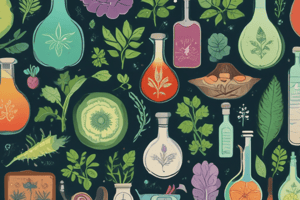Podcast
Questions and Answers
What is considered the most difficult operation in phytochemical research?
What is considered the most difficult operation in phytochemical research?
- Identification of bioactive compounds
- Purification of materials present in a crude extract
- Isolation and purification of plant constituents (correct)
- Separation of volatile mixtures
What is the primary purpose of exploiting chemical properties of functional groups in phytochemical research?
What is the primary purpose of exploiting chemical properties of functional groups in phytochemical research?
- To separate components of the same class
- To purify materials present in a crude extract
- To isolate bioactive compounds
- To separate compounds from other materials (correct)
What is employed in modern sublimation equipment?
What is employed in modern sublimation equipment?
- Variable pressures with a loose control of temperature
- Room pressure with a moderate control of temperature
- High pressures with a strict control of temperature
- Low pressures with a strict control of temperature (correct)
What is the traditional use of fractional distillation in phytochemistry?
What is the traditional use of fractional distillation in phytochemistry?
What is the limitation of exploiting chemical properties of functional groups in phytochemical research?
What is the limitation of exploiting chemical properties of functional groups in phytochemical research?
What is the application of sublimation in phytochemical research?
What is the application of sublimation in phytochemical research?
What is a common challenge when using the traditional method of separating and isolating constituents on a laboratory scale?
What is a common challenge when using the traditional method of separating and isolating constituents on a laboratory scale?
What is the purpose of shaking the mixture with an organic solvent after each addition of alkali in fractional liberation?
What is the purpose of shaking the mixture with an organic solvent after each addition of alkali in fractional liberation?
What is the principle behind fractional crystallization?
What is the principle behind fractional crystallization?
What is the purpose of forming derivatives of the components in fractional crystallization?
What is the purpose of forming derivatives of the components in fractional crystallization?
What is the outcome of treating a mixture of alkaloid salts with alkali in fractional liberation?
What is the outcome of treating a mixture of alkaloid salts with alkali in fractional liberation?
What is the role of mineral acids in the fractional liberation of organic acids?
What is the role of mineral acids in the fractional liberation of organic acids?
What is the fundamental principle of adsorption chromatography?
What is the fundamental principle of adsorption chromatography?
What is the purpose of using charcoal in solutions?
What is the purpose of using charcoal in solutions?
What is the role of the calcium carbonate column in Tswett's experiment?
What is the role of the calcium carbonate column in Tswett's experiment?
Which pigments are more strongly adsorbed in Tswett's experiment?
Which pigments are more strongly adsorbed in Tswett's experiment?
What is the result of the pigments undergoing separation as percolation proceeds?
What is the result of the pigments undergoing separation as percolation proceeds?
Why do the carotenes accumulate lower down in the column?
Why do the carotenes accumulate lower down in the column?
What is the primary purpose of allowing more of the pure solvent to percolate through the column?
What is the primary purpose of allowing more of the pure solvent to percolate through the column?
What is the effect of using a different solvent in the chromatography process?
What is the effect of using a different solvent in the chromatography process?
What happens to the lower bands as percolation continues?
What happens to the lower bands as percolation continues?
What is the term used to describe the process of desorption?
What is the term used to describe the process of desorption?
What is the solution obtained after the process of elution?
What is the solution obtained after the process of elution?
Who is credited with the development of the term 'chromatography'?
Who is credited with the development of the term 'chromatography'?
Flashcards
Gas Chromatography
Gas Chromatography
A technique used for separating and analyzing compounds in a mixture.
Fractional Liberation
Fractional Liberation
Treating a mixture with acid/base to separate constituents in order.
Alkaloid Salts
Alkaloid Salts
Water-soluble compounds obtained from plants, often separated using solvents.
Fractional Crystallization
Fractional Crystallization
Signup and view all the flashcards
Solubility
Solubility
Signup and view all the flashcards
Picrate Derivatives
Picrate Derivatives
Signup and view all the flashcards
Adsorption Chromatography
Adsorption Chromatography
Signup and view all the flashcards
Selective Adsorption
Selective Adsorption
Signup and view all the flashcards
Calcium Carbonate
Calcium Carbonate
Signup and view all the flashcards
Percolation
Percolation
Signup and view all the flashcards
Sublimation
Sublimation
Signup and view all the flashcards
Distillation
Distillation
Signup and view all the flashcards
Fractional Distillation
Fractional Distillation
Signup and view all the flashcards
Volatile Oils
Volatile Oils
Signup and view all the flashcards
Elution
Elution
Signup and view all the flashcards
Efficiency in Chromatography
Efficiency in Chromatography
Signup and view all the flashcards
Adsorbed Materials
Adsorbed Materials
Signup and view all the flashcards
Distinct Bands
Distinct Bands
Signup and view all the flashcards
Desorption
Desorption
Signup and view all the flashcards
Organic Solvent
Organic Solvent
Signup and view all the flashcards
Crude Extract
Crude Extract
Signup and view all the flashcards
Solvent Characteristics
Solvent Characteristics
Signup and view all the flashcards
Components of Mixture
Components of Mixture
Signup and view all the flashcards
Plant Constituents
Plant Constituents
Signup and view all the flashcards
Separation Techniques
Separation Techniques
Signup and view all the flashcards
Study Notes
Separation and Isolation of Constituents
- Separation and isolation of minor components of a mixture are challenging on a laboratory scale, and gas chromatography is often used instead.
- Fractional liberation involves treating a mixture with a base or acid to liberate constituents in a specific order, and then separating them using an organic solvent.
- This method is useful for separating alkaloid salts and organic acids soluble in water-immiscible solvents.
Fractional Crystallization
- Fractional crystallization is a traditional method that exploits differences in solubility of mixture components in a particular solvent.
- Derivatives of the components, such as picrates of alkaloids or osazones of sugars, are often used to facilitate separation.
Adsorption Chromatography
- Adsorption chromatography is a technique that separates and isolates plant constituents based on selective adsorption.
- Finely divided solids have the power to adsorb other substances on their surfaces, and this phenomenon is the fundamental principle of adsorption chromatography.
- The method involves allowing a solution to percolate through a column of a substance, such as powdered calcium carbonate, and separating the components based on their adsorption strengths.
Sublimation and Distillation
- Sublimation is a method that can be used to isolate and purify plant constituents, often employed on the whole drug or for the purification of materials present in a crude extract.
- Distillation, particularly fractional distillation, has been widely used for the separation of volatile mixtures, including the components of volatile oils.
Development of Chromatography
- The process of adsorption chromatography can be developed by allowing more of the pure solvent to percolate through the column, causing the adsorbed materials to slowly pass downwards and separate into distinct bands.
- Using a different solvent, one from which the substances are less strongly adsorbed, can also improve the efficiency of the process.
- The process of desorption, termed elution, can be used to obtain the separated pigments in a solution.
Studying That Suits You
Use AI to generate personalized quizzes and flashcards to suit your learning preferences.




